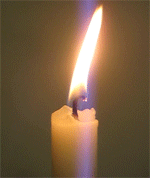To understand the carbon cycle you need to understand burning (combustion) and breathing (respiration). Both result in carbon dioxide gas (CO2) being released into the atmosphere.
 As a candle burns some of the wax "disappears". If you were to weigh the candle before and after you would see a difference in how much it weighs. So where did the candle go?
As a candle burns some of the wax "disappears". If you were to weigh the candle before and after you would see a difference in how much it weighs. So where did the candle go?
When we cover the candle with a beaker, it slowly goes out. The larger the container we use to cover the candle, the longer it takes to go out. What might this tell us?
In many ways living things are like a candle burning. They use oxygen gas (O2) to "burn" food and this generates energy and carbon dioxide gas (CO2). The energy from food can be used for things like movement or generating heat.
The way they do it is different but the end result is the same.
We can think of burning as a chemical reaction.
Candle + Something in Air —> Energy (light and heat) + Gases
Food + Something in Air We Breathe In —> energy + Gases
OR
Candle and Oxygen Gas —> Energy and Carbon Dioxide Gas and Water
Food + Oxygen Gas —> Energy + Carbon Dioxide Gas + Water (as a gas)
The chemical reaction is written as:
Wax (C30H64) + O2 (g) —> energy + CO2 (g) + H2O (g)
Food (C6H12O6) + O2 (g) —> energy + CO2 (g) + H2O (g)
How does this relate to the Carbon Cycle?
- Burning and breathing both use oxygen gas found in the air.
- Burning and breathing both produce energy and carbon dioxide gas.
- Plants use energy from sunlight to change carbon dioxide (CO2) to oxygen (O2). The carbon is used by the plant to grow.
Take a quiz to practice and help you remember:





